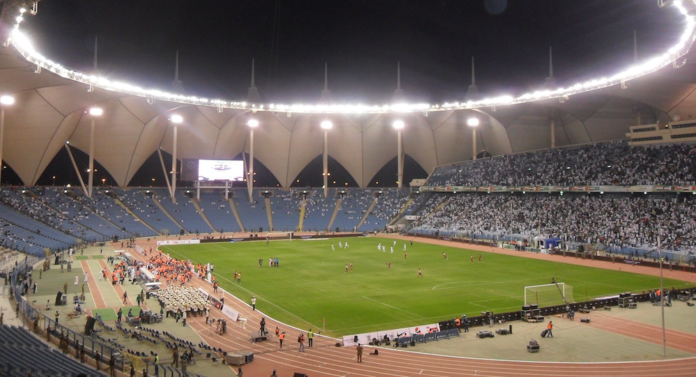RIYADH: Riyadh’s iconic King Fahd International Stadium is set to undergo major changes as Saudi Arabia pushes on with its bid to host the 2027 AFC Asian Cup.
“King Fahd Stadium in Saudi Arabia has marble and gold boxes and carpeted stands, but it has no memory or much of anything to say,” wrote Uruguayan novelist and poet Eduardo Galeano in his 1995 masterpiece “Football in Sun and Shadow” of the then only eight-year-old stadium.
The magical realist author might perhaps have been right at the time but, nearly three decades on, while the impressive gold lining in the VIP lounge and the marble slabs covering the walls and floors of its hallways remain features of this stunning venue, King Fahd International Stadium has also seen its fair share of historic moments and has many stories to tell.
It was here that Portuguese icons Joao Pinto and Fernando Couto lifted the 1989 FIFA Youth World Cup title, having beaten a Brazil side featuring the likes of Sonny Anderson and future world champion Leonardo. It was here that Diego Simeone and Claudio Caniggia scored in the final as Argentina beat Saudi Arabia 3-1 to win the first FIFA Confederations Cup in 1992. It was also here at King Fahd International Stadium that Al-Hilal won the Asian Club Championship title in 2000, beating Japan’s Jubilo Iwata in the final. And the list goes on.
Now, as the Kingdom enters a new era with the materialization of its ambitious Vision 2030 transformation program, King Fahd International Stadium is receiving a substantial upgrade as it eyes securing what would be the jewel in its crown of landmark events. It is being nominated to host the opening and final matches of the 2027 AFC Asian Cup, with the Kingdom leading the contenders to host Asia’s premier national team competition.
Next week, 58,000 fans will flock to the stadium for the final of the 2021 AFC Champions League between Al-Hilal and South Korea’s Pohang Steelers; a game that is set to decide the most successful club in Asian football history, as these teams share the current record of three Champions League titles each.
By the time 2027 rolls around, those same stands will accommodate 80,000 fans, making the ground with the iconic roof in the shape of 24 tents the joint-largest football stadium in the Gulf Cooperation Council states, explained project architect Musab Badahdah.
“The athletics track surrounding the pitch will be removed and the pitch itself will be lowered by eight meters, allowing for a supplemental lower tier of stands to be built, adding over 20,000 seats to the current capacity,” said Badahdah on the eve of the AFC delegation’s inspection visit to the site.
The delegation arrived in the Kingdom after completing a visit to Iran, one of the three other nations in contention to host the 2027 AFC Asian Cup. Similar visits to Qatar and India will follow, as the Asian football governing body continues its evaluation process ahead of it selecting the host of its premier national team competition, which will next take place in China in 2023.
At the heart of Saudi Arabia’s plans to transform its economy is a push for a modern and sustainable public transport network. And, as the capital’s leading sports venue, the King Fahd International Stadium will see its connectivity to the rest of the city boosted by the construction of a Riyadh Metro station just outside the venue. It is due to open in 2022. But car users will still find ample facilities, with more than 6,000 spaces available in the immediate vicinity, according to Badahdah.
Safety has been carefully considered, with the huge bowl boasting 57 exits distributed across its perimeter, with eight entry and exit ramps allowing the complete evacuation of 80,000 fans within seven minutes in case of emergency.
And unlike the traditional setup of most stadiums, with only home and away dressing rooms, Saudi Arabia’s national stadium has four identical and fully equipped dressing rooms with completely separate entry and exit pathways and warm-up areas, allowing for the smooth organization of back-to-back matches during major tournaments.
Saudi Arabia’s bid for 2027 lists three new stadiums: One in Riyadh, one in the nearby future city of Qiddiya, and one in the eastern port city of Dammam. But it is the national stadium, which will be 40 years old at the time of the tournament, that will be the centerpiece of the ambitious plans taking shape under the slogan “Forward for Asia.”

